Comodo Certificate Fraud Hack: A Security Analysis Report
VerifiedAdded on 2022/09/21
|14
|2813
|28
Report
AI Summary
This report delves into the Comodo SSL certificate fraud hack, examining the vulnerabilities exploited by an Iranian hacker. It details the IT security problems, including the lack of understanding of Public Key Infrastructure (PKI) and the issuance of fraudulent certificates. The report highlights major security problems, such as the compromise of customer transaction data and the ignorance surrounding digital certificates. It proposes solutions, emphasizing the importance of educating customers and employees about security practices, and implementing site security checks. The report recommends raising awareness about potential threats and implementing robust security measures to protect customer data and prevent future attacks, focusing on the needs of small to medium-sized businesses.

Running head: COMODO CERTIFICATE FRAUD HACK
Comodo Certificate Fraud Hack
Name of the Student
Name of the University
Author Note
Comodo Certificate Fraud Hack
Name of the Student
Name of the University
Author Note
Paraphrase This Document
Need a fresh take? Get an instant paraphrase of this document with our AI Paraphraser
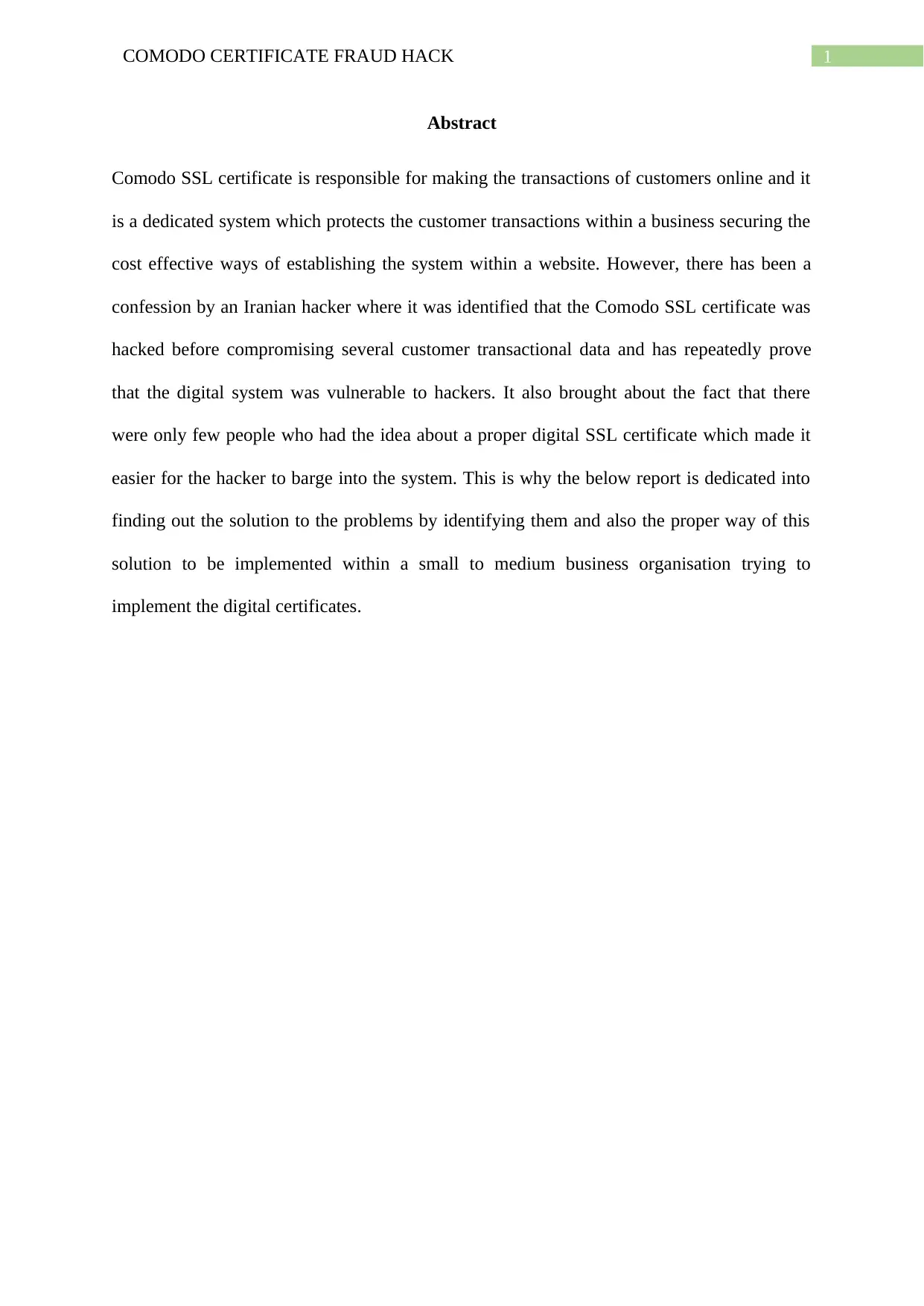
1COMODO CERTIFICATE FRAUD HACK
Abstract
Comodo SSL certificate is responsible for making the transactions of customers online and it
is a dedicated system which protects the customer transactions within a business securing the
cost effective ways of establishing the system within a website. However, there has been a
confession by an Iranian hacker where it was identified that the Comodo SSL certificate was
hacked before compromising several customer transactional data and has repeatedly prove
that the digital system was vulnerable to hackers. It also brought about the fact that there
were only few people who had the idea about a proper digital SSL certificate which made it
easier for the hacker to barge into the system. This is why the below report is dedicated into
finding out the solution to the problems by identifying them and also the proper way of this
solution to be implemented within a small to medium business organisation trying to
implement the digital certificates.
Abstract
Comodo SSL certificate is responsible for making the transactions of customers online and it
is a dedicated system which protects the customer transactions within a business securing the
cost effective ways of establishing the system within a website. However, there has been a
confession by an Iranian hacker where it was identified that the Comodo SSL certificate was
hacked before compromising several customer transactional data and has repeatedly prove
that the digital system was vulnerable to hackers. It also brought about the fact that there
were only few people who had the idea about a proper digital SSL certificate which made it
easier for the hacker to barge into the system. This is why the below report is dedicated into
finding out the solution to the problems by identifying them and also the proper way of this
solution to be implemented within a small to medium business organisation trying to
implement the digital certificates.

2COMODO CERTIFICATE FRAUD HACK
Table of Contents
Introduction................................................................................................................................3
Background information........................................................................................................3
A description of the IT security problem...............................................................................4
Major security problems it proposes......................................................................................5
Proposed Solution..................................................................................................................7
Recommendation........................................................................................................................8
Conclusion..................................................................................................................................8
References................................................................................................................................10
Appendix..................................................................................................................................12
Table of Contents
Introduction................................................................................................................................3
Background information........................................................................................................3
A description of the IT security problem...............................................................................4
Major security problems it proposes......................................................................................5
Proposed Solution..................................................................................................................7
Recommendation........................................................................................................................8
Conclusion..................................................................................................................................8
References................................................................................................................................10
Appendix..................................................................................................................................12
⊘ This is a preview!⊘
Do you want full access?
Subscribe today to unlock all pages.

Trusted by 1+ million students worldwide
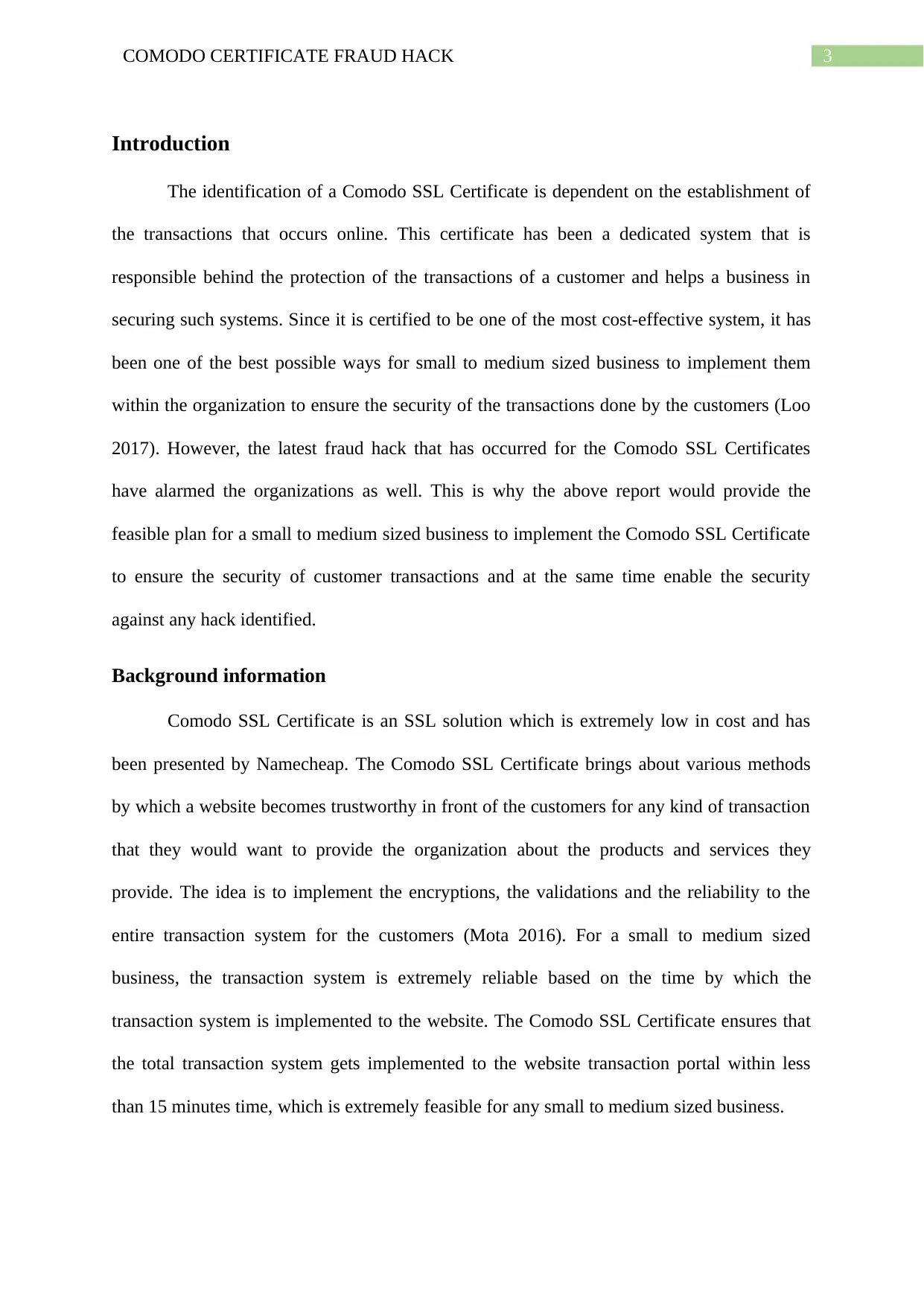
3COMODO CERTIFICATE FRAUD HACK
Introduction
The identification of a Comodo SSL Certificate is dependent on the establishment of
the transactions that occurs online. This certificate has been a dedicated system that is
responsible behind the protection of the transactions of a customer and helps a business in
securing such systems. Since it is certified to be one of the most cost-effective system, it has
been one of the best possible ways for small to medium sized business to implement them
within the organization to ensure the security of the transactions done by the customers (Loo
2017). However, the latest fraud hack that has occurred for the Comodo SSL Certificates
have alarmed the organizations as well. This is why the above report would provide the
feasible plan for a small to medium sized business to implement the Comodo SSL Certificate
to ensure the security of customer transactions and at the same time enable the security
against any hack identified.
Background information
Comodo SSL Certificate is an SSL solution which is extremely low in cost and has
been presented by Namecheap. The Comodo SSL Certificate brings about various methods
by which a website becomes trustworthy in front of the customers for any kind of transaction
that they would want to provide the organization about the products and services they
provide. The idea is to implement the encryptions, the validations and the reliability to the
entire transaction system for the customers (Mota 2016). For a small to medium sized
business, the transaction system is extremely reliable based on the time by which the
transaction system is implemented to the website. The Comodo SSL Certificate ensures that
the total transaction system gets implemented to the website transaction portal within less
than 15 minutes time, which is extremely feasible for any small to medium sized business.
Introduction
The identification of a Comodo SSL Certificate is dependent on the establishment of
the transactions that occurs online. This certificate has been a dedicated system that is
responsible behind the protection of the transactions of a customer and helps a business in
securing such systems. Since it is certified to be one of the most cost-effective system, it has
been one of the best possible ways for small to medium sized business to implement them
within the organization to ensure the security of the transactions done by the customers (Loo
2017). However, the latest fraud hack that has occurred for the Comodo SSL Certificates
have alarmed the organizations as well. This is why the above report would provide the
feasible plan for a small to medium sized business to implement the Comodo SSL Certificate
to ensure the security of customer transactions and at the same time enable the security
against any hack identified.
Background information
Comodo SSL Certificate is an SSL solution which is extremely low in cost and has
been presented by Namecheap. The Comodo SSL Certificate brings about various methods
by which a website becomes trustworthy in front of the customers for any kind of transaction
that they would want to provide the organization about the products and services they
provide. The idea is to implement the encryptions, the validations and the reliability to the
entire transaction system for the customers (Mota 2016). For a small to medium sized
business, the transaction system is extremely reliable based on the time by which the
transaction system is implemented to the website. The Comodo SSL Certificate ensures that
the total transaction system gets implemented to the website transaction portal within less
than 15 minutes time, which is extremely feasible for any small to medium sized business.
Paraphrase This Document
Need a fresh take? Get an instant paraphrase of this document with our AI Paraphraser

4COMODO CERTIFICATE FRAUD HACK
However, there are also several areas of concern that may make it difficult for small
to medium sized business in investing into this system as there has been several areas of
concern that raises several issues about the security of the Comodo SSL Certificate system.
This includes the latest fraud hack that has been into the news recently. The hack was
reported to be initiated from the side of an Iranian hacker who has been responsible for
duping the certification authority for the Comodo SSL Certificates. The hacker issued the
digital certificates and tried to issue it further to many unauthorized parties creating a huge
ruckus in the Information Technology front (Berkowsky and Hayajneh 2017). The
Information Technology community of organizations were such disturbed by the incident that
they were found to be contacting Mozilla and Microsoft for permanently removing the
intervention of Comodo as an authorized certificate for the transactions. This was found to be
not just the intervention of the technical issues that was led on by the hacker, but it was found
that the issue has also been about the least understanding of the Public key Infrastructure or
the PKI and the digital certification that normal website and cyber users do not understand
completely. This is the main idea that is required for any business to understand because this
is the primary requirement for identifying the Comodo hack is extremely necessary to save a
small to medium business organisation in order to make sure that the customer transaction
data is secured.
A description of the IT security problem
PKI was not the only reason that the system failed and fell into the hands off the
hacker. The designers who had made the system design for PKI whatever about the
fraudulent issued certificate that were in vogue right at the design phase. This is why they
implement into a river location system within the PKI that have the ability to you notice any
fraudulent activity when it occurred and also this system had the ability of revoked the
involved vendors and inform the security updates about revocation (Kang, Fahd and
However, there are also several areas of concern that may make it difficult for small
to medium sized business in investing into this system as there has been several areas of
concern that raises several issues about the security of the Comodo SSL Certificate system.
This includes the latest fraud hack that has been into the news recently. The hack was
reported to be initiated from the side of an Iranian hacker who has been responsible for
duping the certification authority for the Comodo SSL Certificates. The hacker issued the
digital certificates and tried to issue it further to many unauthorized parties creating a huge
ruckus in the Information Technology front (Berkowsky and Hayajneh 2017). The
Information Technology community of organizations were such disturbed by the incident that
they were found to be contacting Mozilla and Microsoft for permanently removing the
intervention of Comodo as an authorized certificate for the transactions. This was found to be
not just the intervention of the technical issues that was led on by the hacker, but it was found
that the issue has also been about the least understanding of the Public key Infrastructure or
the PKI and the digital certification that normal website and cyber users do not understand
completely. This is the main idea that is required for any business to understand because this
is the primary requirement for identifying the Comodo hack is extremely necessary to save a
small to medium business organisation in order to make sure that the customer transaction
data is secured.
A description of the IT security problem
PKI was not the only reason that the system failed and fell into the hands off the
hacker. The designers who had made the system design for PKI whatever about the
fraudulent issued certificate that were in vogue right at the design phase. This is why they
implement into a river location system within the PKI that have the ability to you notice any
fraudulent activity when it occurred and also this system had the ability of revoked the
involved vendors and inform the security updates about revocation (Kang, Fahd and
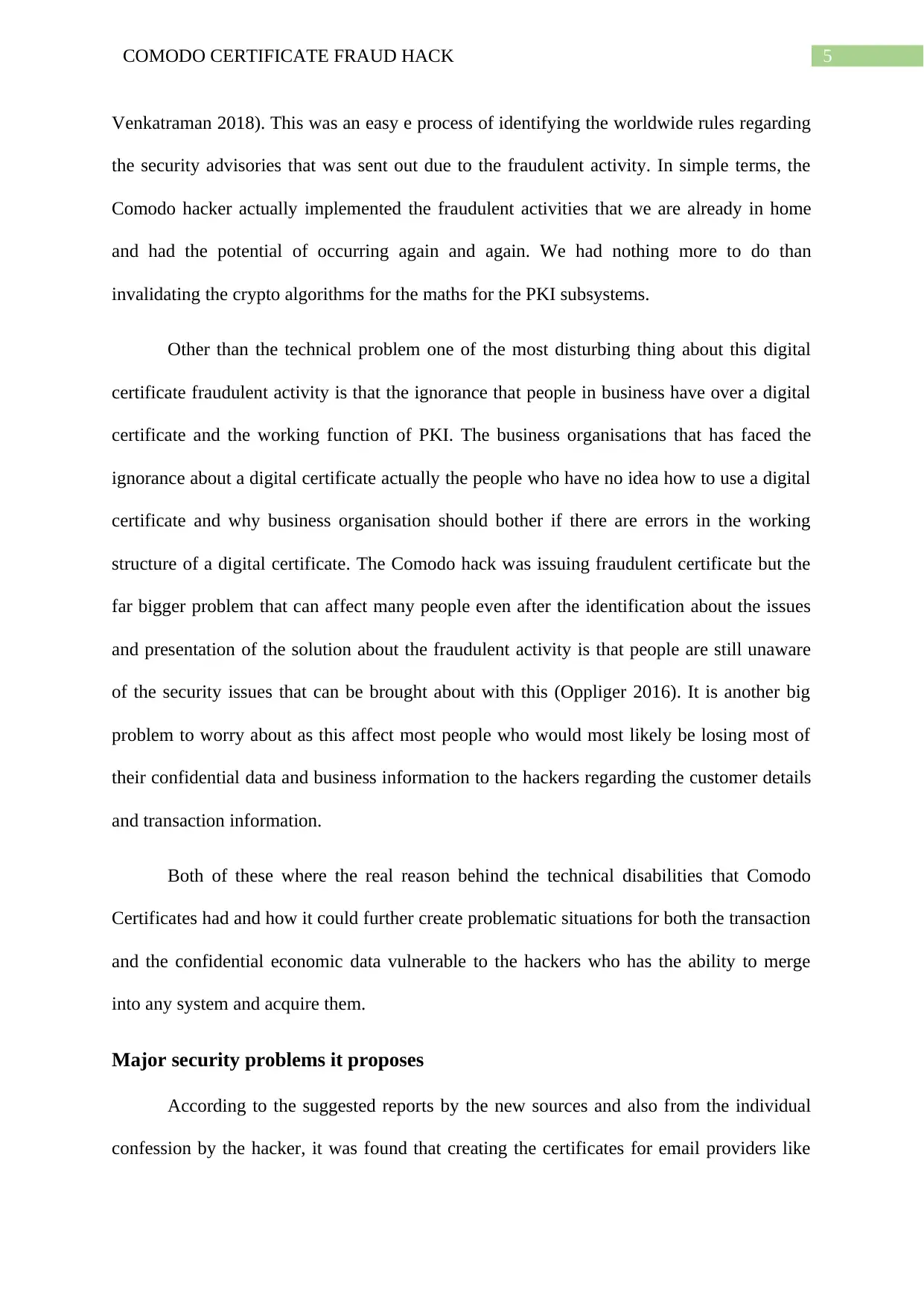
5COMODO CERTIFICATE FRAUD HACK
Venkatraman 2018). This was an easy e process of identifying the worldwide rules regarding
the security advisories that was sent out due to the fraudulent activity. In simple terms, the
Comodo hacker actually implemented the fraudulent activities that we are already in home
and had the potential of occurring again and again. We had nothing more to do than
invalidating the crypto algorithms for the maths for the PKI subsystems.
Other than the technical problem one of the most disturbing thing about this digital
certificate fraudulent activity is that the ignorance that people in business have over a digital
certificate and the working function of PKI. The business organisations that has faced the
ignorance about a digital certificate actually the people who have no idea how to use a digital
certificate and why business organisation should bother if there are errors in the working
structure of a digital certificate. The Comodo hack was issuing fraudulent certificate but the
far bigger problem that can affect many people even after the identification about the issues
and presentation of the solution about the fraudulent activity is that people are still unaware
of the security issues that can be brought about with this (Oppliger 2016). It is another big
problem to worry about as this affect most people who would most likely be losing most of
their confidential data and business information to the hackers regarding the customer details
and transaction information.
Both of these where the real reason behind the technical disabilities that Comodo
Certificates had and how it could further create problematic situations for both the transaction
and the confidential economic data vulnerable to the hackers who has the ability to merge
into any system and acquire them.
Major security problems it proposes
According to the suggested reports by the new sources and also from the individual
confession by the hacker, it was found that creating the certificates for email providers like
Venkatraman 2018). This was an easy e process of identifying the worldwide rules regarding
the security advisories that was sent out due to the fraudulent activity. In simple terms, the
Comodo hacker actually implemented the fraudulent activities that we are already in home
and had the potential of occurring again and again. We had nothing more to do than
invalidating the crypto algorithms for the maths for the PKI subsystems.
Other than the technical problem one of the most disturbing thing about this digital
certificate fraudulent activity is that the ignorance that people in business have over a digital
certificate and the working function of PKI. The business organisations that has faced the
ignorance about a digital certificate actually the people who have no idea how to use a digital
certificate and why business organisation should bother if there are errors in the working
structure of a digital certificate. The Comodo hack was issuing fraudulent certificate but the
far bigger problem that can affect many people even after the identification about the issues
and presentation of the solution about the fraudulent activity is that people are still unaware
of the security issues that can be brought about with this (Oppliger 2016). It is another big
problem to worry about as this affect most people who would most likely be losing most of
their confidential data and business information to the hackers regarding the customer details
and transaction information.
Both of these where the real reason behind the technical disabilities that Comodo
Certificates had and how it could further create problematic situations for both the transaction
and the confidential economic data vulnerable to the hackers who has the ability to merge
into any system and acquire them.
Major security problems it proposes
According to the suggested reports by the new sources and also from the individual
confession by the hacker, it was found that creating the certificates for email providers like
⊘ This is a preview!⊘
Do you want full access?
Subscribe today to unlock all pages.

Trusted by 1+ million students worldwide

6COMODO CERTIFICATE FRAUD HACK
Yahoo, Gmail and Hotmail was done by an Iranian patriot who was also known as
‘comodohacker’ (Jayaraman, Li and Evans 2017). After all the responsibility cleaned by the
hacker there were several analysis about the problems that where forming the major issues
about the hack ok and how the weaknesses in the SSL certification where vulnerable for the
security breach. The Hijacked certificates were duped by the government of Iran and was
release as electronic certificates for allowing the region of the country to snoop on the
citizens (Radif 2018). It was also the vulnerability of the Comodo Certificates that resulted
into the incompetency and the main responsibility of being the vulnerable and untrustworthy
source and exposing the customers to the hacker. When the ethical hackers found out the site
for Comodo and its hacking done from an Iranian IP address, it was found that there were
three primary questions that possibly would have been asked to the technical designer behind
the digital certificates. It was a major issue to identify the working of the Iranian IP address
on their assurance of merging into the Comodo website with username and password and
enough clearance for creating the SSL certificates. This would mean that there are some sort
of vulnerability that the hacker could birds into the website with proper username and
password and also get enough clearance to create the SSL certificate. It was also question to
be asked to Comodo about how did they have SSL certificate generated for google.com,
live.com, yahoo.com, skype.com and mozilla.org (Lozupone 2018). It was even in question if
there was anybody responsible over watching these SSL certificates. It was also a major
issues that browser updates revoked the SSL certificate which was not even legal.
This is one of the major issues that were rest against the fraudulent activities to ask
about the working of the digital certificates. When a user goes online over any https address
the encryption of the browser communication is setup with the website (Parmar and Verma
2017). The public key cryptography sets of the mechanics behind the connection and the
browser website implement the encryption process with the exchange of the public keys. The
Yahoo, Gmail and Hotmail was done by an Iranian patriot who was also known as
‘comodohacker’ (Jayaraman, Li and Evans 2017). After all the responsibility cleaned by the
hacker there were several analysis about the problems that where forming the major issues
about the hack ok and how the weaknesses in the SSL certification where vulnerable for the
security breach. The Hijacked certificates were duped by the government of Iran and was
release as electronic certificates for allowing the region of the country to snoop on the
citizens (Radif 2018). It was also the vulnerability of the Comodo Certificates that resulted
into the incompetency and the main responsibility of being the vulnerable and untrustworthy
source and exposing the customers to the hacker. When the ethical hackers found out the site
for Comodo and its hacking done from an Iranian IP address, it was found that there were
three primary questions that possibly would have been asked to the technical designer behind
the digital certificates. It was a major issue to identify the working of the Iranian IP address
on their assurance of merging into the Comodo website with username and password and
enough clearance for creating the SSL certificates. This would mean that there are some sort
of vulnerability that the hacker could birds into the website with proper username and
password and also get enough clearance to create the SSL certificate. It was also question to
be asked to Comodo about how did they have SSL certificate generated for google.com,
live.com, yahoo.com, skype.com and mozilla.org (Lozupone 2018). It was even in question if
there was anybody responsible over watching these SSL certificates. It was also a major
issues that browser updates revoked the SSL certificate which was not even legal.
This is one of the major issues that were rest against the fraudulent activities to ask
about the working of the digital certificates. When a user goes online over any https address
the encryption of the browser communication is setup with the website (Parmar and Verma
2017). The public key cryptography sets of the mechanics behind the connection and the
browser website implement the encryption process with the exchange of the public keys. The
Paraphrase This Document
Need a fresh take? Get an instant paraphrase of this document with our AI Paraphraser
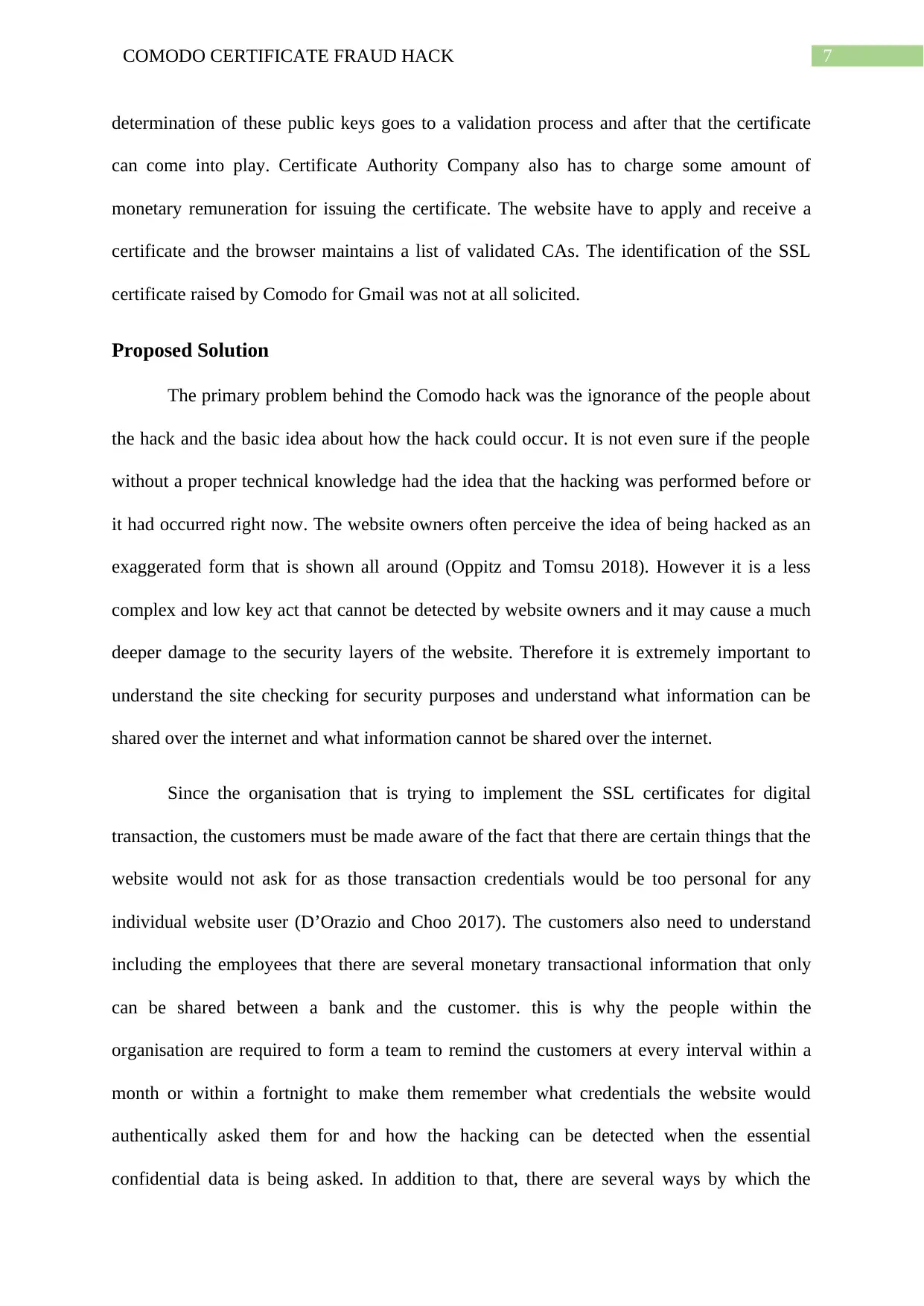
7COMODO CERTIFICATE FRAUD HACK
determination of these public keys goes to a validation process and after that the certificate
can come into play. Certificate Authority Company also has to charge some amount of
monetary remuneration for issuing the certificate. The website have to apply and receive a
certificate and the browser maintains a list of validated CAs. The identification of the SSL
certificate raised by Comodo for Gmail was not at all solicited.
Proposed Solution
The primary problem behind the Comodo hack was the ignorance of the people about
the hack and the basic idea about how the hack could occur. It is not even sure if the people
without a proper technical knowledge had the idea that the hacking was performed before or
it had occurred right now. The website owners often perceive the idea of being hacked as an
exaggerated form that is shown all around (Oppitz and Tomsu 2018). However it is a less
complex and low key act that cannot be detected by website owners and it may cause a much
deeper damage to the security layers of the website. Therefore it is extremely important to
understand the site checking for security purposes and understand what information can be
shared over the internet and what information cannot be shared over the internet.
Since the organisation that is trying to implement the SSL certificates for digital
transaction, the customers must be made aware of the fact that there are certain things that the
website would not ask for as those transaction credentials would be too personal for any
individual website user (D’Orazio and Choo 2017). The customers also need to understand
including the employees that there are several monetary transactional information that only
can be shared between a bank and the customer. this is why the people within the
organisation are required to form a team to remind the customers at every interval within a
month or within a fortnight to make them remember what credentials the website would
authentically asked them for and how the hacking can be detected when the essential
confidential data is being asked. In addition to that, there are several ways by which the
determination of these public keys goes to a validation process and after that the certificate
can come into play. Certificate Authority Company also has to charge some amount of
monetary remuneration for issuing the certificate. The website have to apply and receive a
certificate and the browser maintains a list of validated CAs. The identification of the SSL
certificate raised by Comodo for Gmail was not at all solicited.
Proposed Solution
The primary problem behind the Comodo hack was the ignorance of the people about
the hack and the basic idea about how the hack could occur. It is not even sure if the people
without a proper technical knowledge had the idea that the hacking was performed before or
it had occurred right now. The website owners often perceive the idea of being hacked as an
exaggerated form that is shown all around (Oppitz and Tomsu 2018). However it is a less
complex and low key act that cannot be detected by website owners and it may cause a much
deeper damage to the security layers of the website. Therefore it is extremely important to
understand the site checking for security purposes and understand what information can be
shared over the internet and what information cannot be shared over the internet.
Since the organisation that is trying to implement the SSL certificates for digital
transaction, the customers must be made aware of the fact that there are certain things that the
website would not ask for as those transaction credentials would be too personal for any
individual website user (D’Orazio and Choo 2017). The customers also need to understand
including the employees that there are several monetary transactional information that only
can be shared between a bank and the customer. this is why the people within the
organisation are required to form a team to remind the customers at every interval within a
month or within a fortnight to make them remember what credentials the website would
authentically asked them for and how the hacking can be detected when the essential
confidential data is being asked. In addition to that, there are several ways by which the

8COMODO CERTIFICATE FRAUD HACK
organisation can and check the site security. The safety check can be done by various ways
and even online streaming of this security check is readily available.
Recommendation
Therefore, as per the findings discovered as above, it must be kept in mind that the
primary problem that the website certificate fraud had faced was the security printing and
compromising of customer transactional data by the Iranian hacker. It was found that the
primary problem behind this was the ignorance of the people about out the Comodo hack. It
is extremely important for every organisation and its customer to be aware about a digital
SSL certificate and how it works. It also needs to be understood that the primary problem
behind this digital certificate is the identification of the credentials that can be shared over the
internet and that cannot be shared over the internet. If there is an awareness program
generalized by the organisation for all the customers, there would be a quick identification of
the SSL certificate frauds with random security checks of the website. Fraud hacks like this
would less likely or won't occur at all for the near future.
Conclusion
Therefore in conclusion it can be said that the Comodo SSL certificate hack occurred
due to the vulnerability that was present within the websites and the lack of proper vigilance
over these websites and their online transactional systems. The organisation should have been
much more careful about the vulnerabilities that were already present with the utilisation of
the SSL digital certificates. It was also a shocking fact that mostly the people behind the
websites who are utilising the benefits of the SSL certificates where not at all aware about the
idea of what a digital certificate is. Therefore the above mentioned problem has been
identified with a proposed solution to let the SSL digital certificates be implemented in in an
organisation can and check the site security. The safety check can be done by various ways
and even online streaming of this security check is readily available.
Recommendation
Therefore, as per the findings discovered as above, it must be kept in mind that the
primary problem that the website certificate fraud had faced was the security printing and
compromising of customer transactional data by the Iranian hacker. It was found that the
primary problem behind this was the ignorance of the people about out the Comodo hack. It
is extremely important for every organisation and its customer to be aware about a digital
SSL certificate and how it works. It also needs to be understood that the primary problem
behind this digital certificate is the identification of the credentials that can be shared over the
internet and that cannot be shared over the internet. If there is an awareness program
generalized by the organisation for all the customers, there would be a quick identification of
the SSL certificate frauds with random security checks of the website. Fraud hacks like this
would less likely or won't occur at all for the near future.
Conclusion
Therefore in conclusion it can be said that the Comodo SSL certificate hack occurred
due to the vulnerability that was present within the websites and the lack of proper vigilance
over these websites and their online transactional systems. The organisation should have been
much more careful about the vulnerabilities that were already present with the utilisation of
the SSL digital certificates. It was also a shocking fact that mostly the people behind the
websites who are utilising the benefits of the SSL certificates where not at all aware about the
idea of what a digital certificate is. Therefore the above mentioned problem has been
identified with a proposed solution to let the SSL digital certificates be implemented in in an
⊘ This is a preview!⊘
Do you want full access?
Subscribe today to unlock all pages.

Trusted by 1+ million students worldwide

9COMODO CERTIFICATE FRAUD HACK
organisation consisting of hundred employees and identified as a small to medium
organisation.
organisation consisting of hundred employees and identified as a small to medium
organisation.
Paraphrase This Document
Need a fresh take? Get an instant paraphrase of this document with our AI Paraphraser
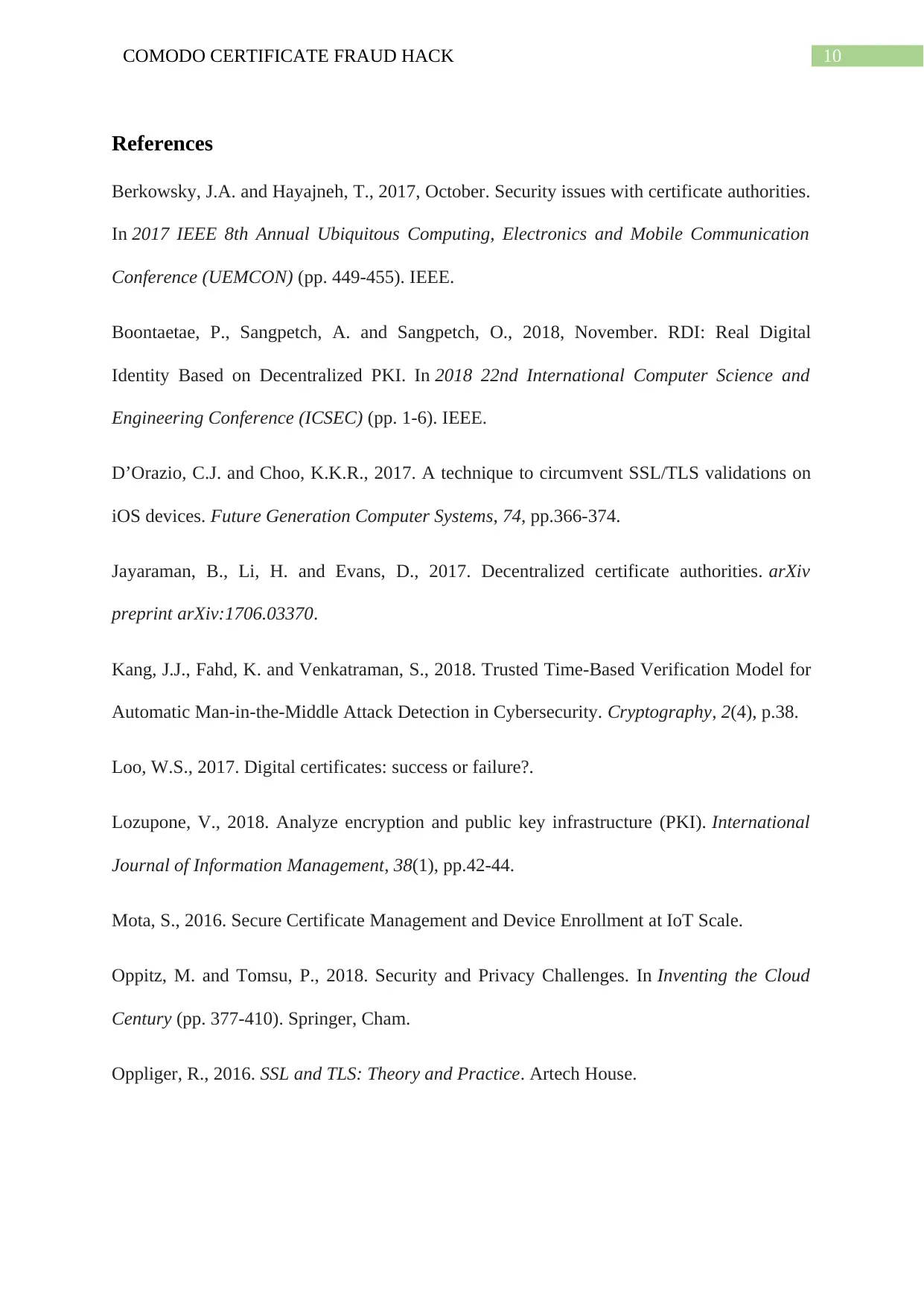
10COMODO CERTIFICATE FRAUD HACK
References
Berkowsky, J.A. and Hayajneh, T., 2017, October. Security issues with certificate authorities.
In 2017 IEEE 8th Annual Ubiquitous Computing, Electronics and Mobile Communication
Conference (UEMCON) (pp. 449-455). IEEE.
Boontaetae, P., Sangpetch, A. and Sangpetch, O., 2018, November. RDI: Real Digital
Identity Based on Decentralized PKI. In 2018 22nd International Computer Science and
Engineering Conference (ICSEC) (pp. 1-6). IEEE.
D’Orazio, C.J. and Choo, K.K.R., 2017. A technique to circumvent SSL/TLS validations on
iOS devices. Future Generation Computer Systems, 74, pp.366-374.
Jayaraman, B., Li, H. and Evans, D., 2017. Decentralized certificate authorities. arXiv
preprint arXiv:1706.03370.
Kang, J.J., Fahd, K. and Venkatraman, S., 2018. Trusted Time-Based Verification Model for
Automatic Man-in-the-Middle Attack Detection in Cybersecurity. Cryptography, 2(4), p.38.
Loo, W.S., 2017. Digital certificates: success or failure?.
Lozupone, V., 2018. Analyze encryption and public key infrastructure (PKI). International
Journal of Information Management, 38(1), pp.42-44.
Mota, S., 2016. Secure Certificate Management and Device Enrollment at IoT Scale.
Oppitz, M. and Tomsu, P., 2018. Security and Privacy Challenges. In Inventing the Cloud
Century (pp. 377-410). Springer, Cham.
Oppliger, R., 2016. SSL and TLS: Theory and Practice. Artech House.
References
Berkowsky, J.A. and Hayajneh, T., 2017, October. Security issues with certificate authorities.
In 2017 IEEE 8th Annual Ubiquitous Computing, Electronics and Mobile Communication
Conference (UEMCON) (pp. 449-455). IEEE.
Boontaetae, P., Sangpetch, A. and Sangpetch, O., 2018, November. RDI: Real Digital
Identity Based on Decentralized PKI. In 2018 22nd International Computer Science and
Engineering Conference (ICSEC) (pp. 1-6). IEEE.
D’Orazio, C.J. and Choo, K.K.R., 2017. A technique to circumvent SSL/TLS validations on
iOS devices. Future Generation Computer Systems, 74, pp.366-374.
Jayaraman, B., Li, H. and Evans, D., 2017. Decentralized certificate authorities. arXiv
preprint arXiv:1706.03370.
Kang, J.J., Fahd, K. and Venkatraman, S., 2018. Trusted Time-Based Verification Model for
Automatic Man-in-the-Middle Attack Detection in Cybersecurity. Cryptography, 2(4), p.38.
Loo, W.S., 2017. Digital certificates: success or failure?.
Lozupone, V., 2018. Analyze encryption and public key infrastructure (PKI). International
Journal of Information Management, 38(1), pp.42-44.
Mota, S., 2016. Secure Certificate Management and Device Enrollment at IoT Scale.
Oppitz, M. and Tomsu, P., 2018. Security and Privacy Challenges. In Inventing the Cloud
Century (pp. 377-410). Springer, Cham.
Oppliger, R., 2016. SSL and TLS: Theory and Practice. Artech House.
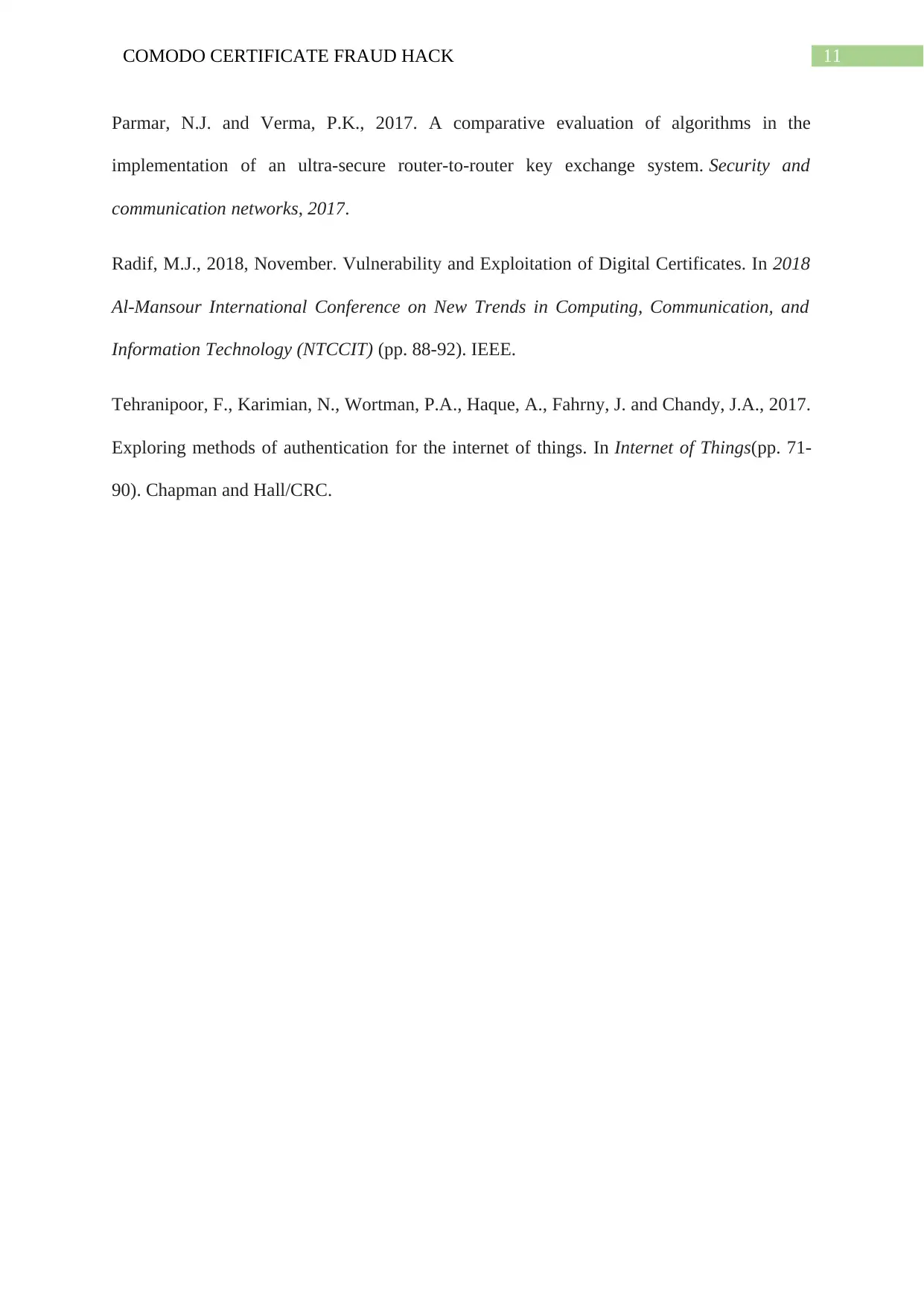
11COMODO CERTIFICATE FRAUD HACK
Parmar, N.J. and Verma, P.K., 2017. A comparative evaluation of algorithms in the
implementation of an ultra-secure router-to-router key exchange system. Security and
communication networks, 2017.
Radif, M.J., 2018, November. Vulnerability and Exploitation of Digital Certificates. In 2018
Al-Mansour International Conference on New Trends in Computing, Communication, and
Information Technology (NTCCIT) (pp. 88-92). IEEE.
Tehranipoor, F., Karimian, N., Wortman, P.A., Haque, A., Fahrny, J. and Chandy, J.A., 2017.
Exploring methods of authentication for the internet of things. In Internet of Things(pp. 71-
90). Chapman and Hall/CRC.
Parmar, N.J. and Verma, P.K., 2017. A comparative evaluation of algorithms in the
implementation of an ultra-secure router-to-router key exchange system. Security and
communication networks, 2017.
Radif, M.J., 2018, November. Vulnerability and Exploitation of Digital Certificates. In 2018
Al-Mansour International Conference on New Trends in Computing, Communication, and
Information Technology (NTCCIT) (pp. 88-92). IEEE.
Tehranipoor, F., Karimian, N., Wortman, P.A., Haque, A., Fahrny, J. and Chandy, J.A., 2017.
Exploring methods of authentication for the internet of things. In Internet of Things(pp. 71-
90). Chapman and Hall/CRC.
⊘ This is a preview!⊘
Do you want full access?
Subscribe today to unlock all pages.

Trusted by 1+ million students worldwide
1 out of 14
Related Documents
Your All-in-One AI-Powered Toolkit for Academic Success.
+13062052269
info@desklib.com
Available 24*7 on WhatsApp / Email
![[object Object]](/_next/static/media/star-bottom.7253800d.svg)
Unlock your academic potential
Copyright © 2020–2025 A2Z Services. All Rights Reserved. Developed and managed by ZUCOL.



